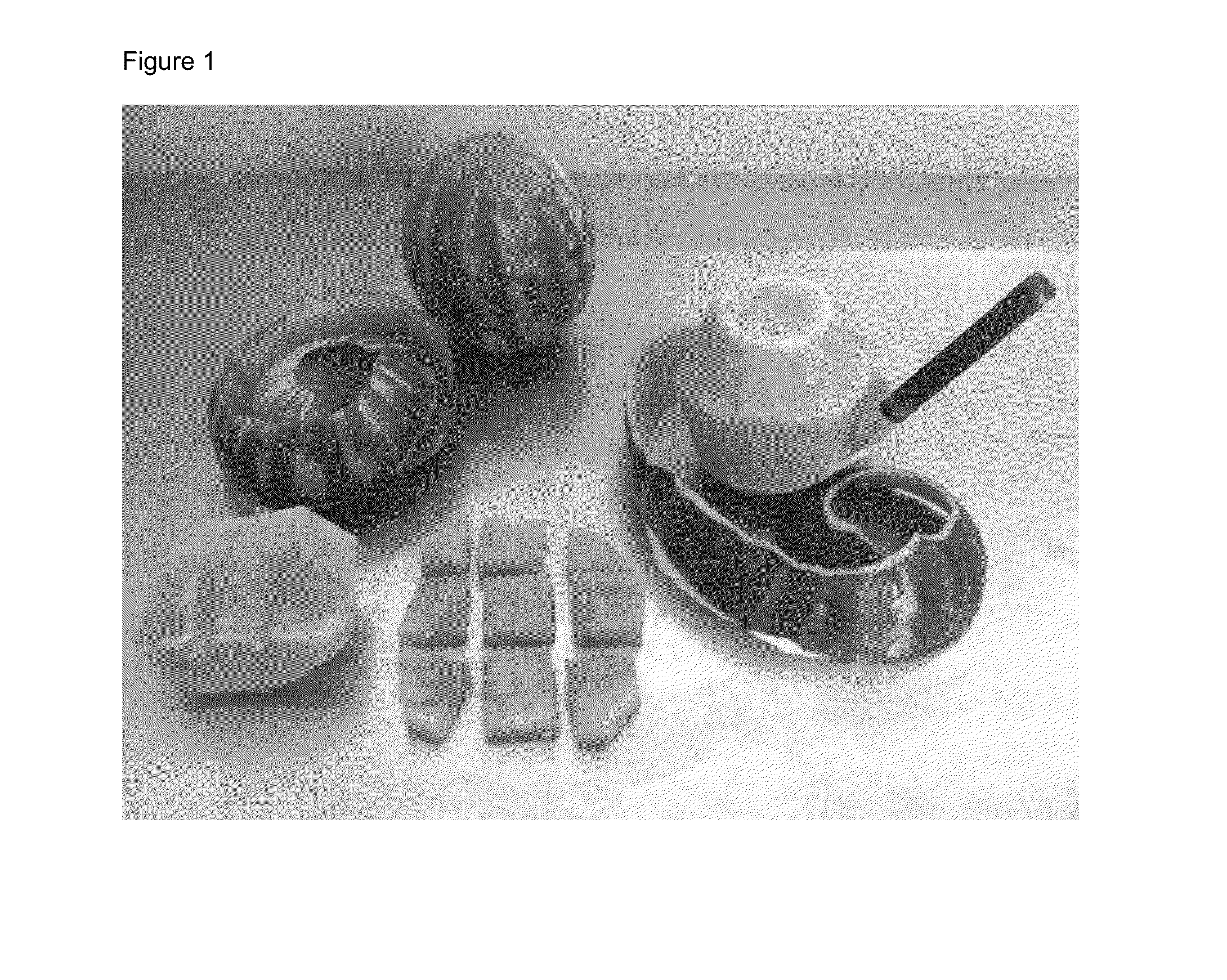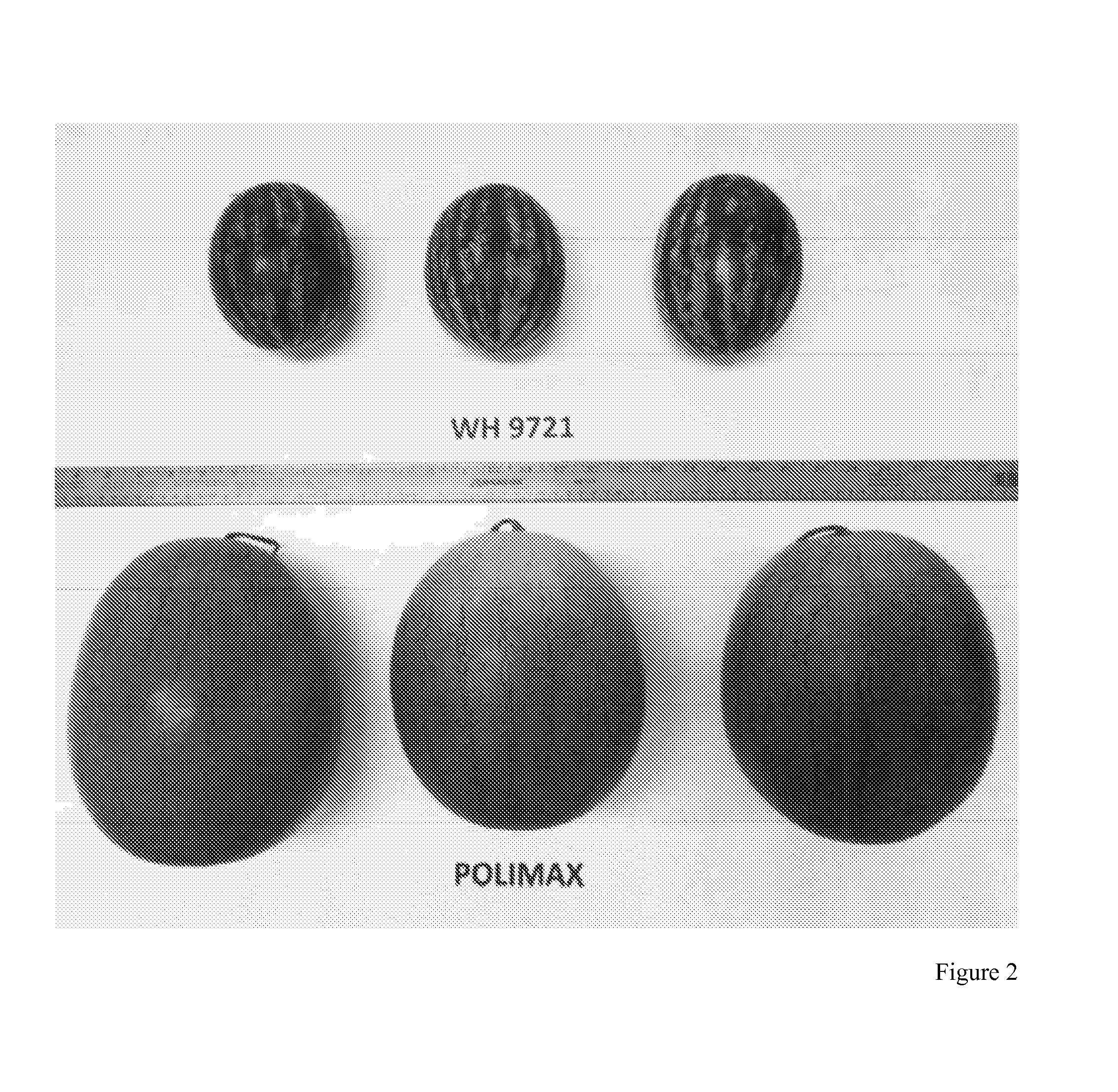Dual purpose pollenizer watermelons
a pollenizer and watermelons technology, applied in the field of watermelon breeding and watermelon improvement, can solve the problems of unsuitable consumption and marketing fruits, poor quality pink-fleshed fruits, low brix value, etc., and achieve good triploid fruit yield and fruit set good
- Summary
- Abstract
- Description
- Claims
- Application Information
AI Technical Summary
Benefits of technology
Problems solved by technology
Method used
Image
Examples
example 1
Breeding History
[0152]Breeding for the hybrids goes back to 1985, to in-house breeding lines and crosses of these with the variety Allsweet. Selected self-pollinations were backcrossed with Tomato Seed OP (Sugar Baby mutant; is gene) and selections were made for red flesh and small seed. Further self-pollinations were selected for red flesh, small seeds and agronomic traits in general. Selections were crossed with a line with many male flowers, followed by several selfings and selection for the production of many male flowers and small red fruits.
example 2
Pollenizer Characteristics
2.1—Materials and Methods
[0153]A field trial was conducted in Italy (Sant'Agata Bolognese—BO). Seeds were sown on 7 Apr. 2010 and transplanted into the field on 21 May 2010 (100 cm within the row, 250 cm between the rows). The plot contained 10 plants per line. Fruits were harvested on 26 / 27 Jul. 2010 for evaluation.
2.1.1 Flowering
[0154]The number of open male and female flowers were counted for three plants per line on the flowering date (day 1=24 Jun. 2010), and 8, 15 and 22 days after the flowering date (day 8=2 Jul. 2010; day 15=9 Jul. 2010; day 22=16 Jul. 2010). The mean number of three plants per line was calculated.
2.1.2 Fruits
[0155]1) Average fruit number: at maturity (26 / 27 July) the total number of fruits harvested from two plants was counted and the average fruit number determined.
[0156]2) Average fruit weight: mean of the weight of three fruits per line randomly harvested from two plants at maturity
[0157]3) Brix: Value is the mean of three readi...
example 3
Use of Pollenizers According to the Invention
3.1—Trial Set-Up
[0174]Three trials were carried out in Spain using pollenizers WH9317x, WH9318x, WH9320x and WH9321x for triploid fruit production on the triploid hybrid variety ‘Fashion’.
Trial 1:
[0175]Location: green house
Trial dimensions: 3600 m2
Transplanting date: 19 Mar. 2010
Harvest date: 16 Jun. 2010
Scheme: pollenizers and triploids were in separate rows, alternating one row of triploid and one row of pollenizer. Distance between rows was 3 meter, distance between plants in a row was 1 meter.
Trial 2:
[0176]Location: open field
Trial dimensions: 2500 m2
Transplanting date: 24 Mar. 2010
Harvest date: 6 Jul. 2010
Scheme: pollenizers and triploids were interplanted in the same rows, with pollenizers making up 25% of the total plants. Distance between rows was 3 meters and distance between plants in a row was 1 meter.
Trial 3:
[0177]Location: open field
Trial dimensions: 1500 m2
Transplanting date: 20 Mar. 2010
Harvest date: 2 Jul. 2010
Scheme: p...
PUM
 Login to View More
Login to View More Abstract
Description
Claims
Application Information
 Login to View More
Login to View More - R&D
- Intellectual Property
- Life Sciences
- Materials
- Tech Scout
- Unparalleled Data Quality
- Higher Quality Content
- 60% Fewer Hallucinations
Browse by: Latest US Patents, China's latest patents, Technical Efficacy Thesaurus, Application Domain, Technology Topic, Popular Technical Reports.
© 2025 PatSnap. All rights reserved.Legal|Privacy policy|Modern Slavery Act Transparency Statement|Sitemap|About US| Contact US: help@patsnap.com


